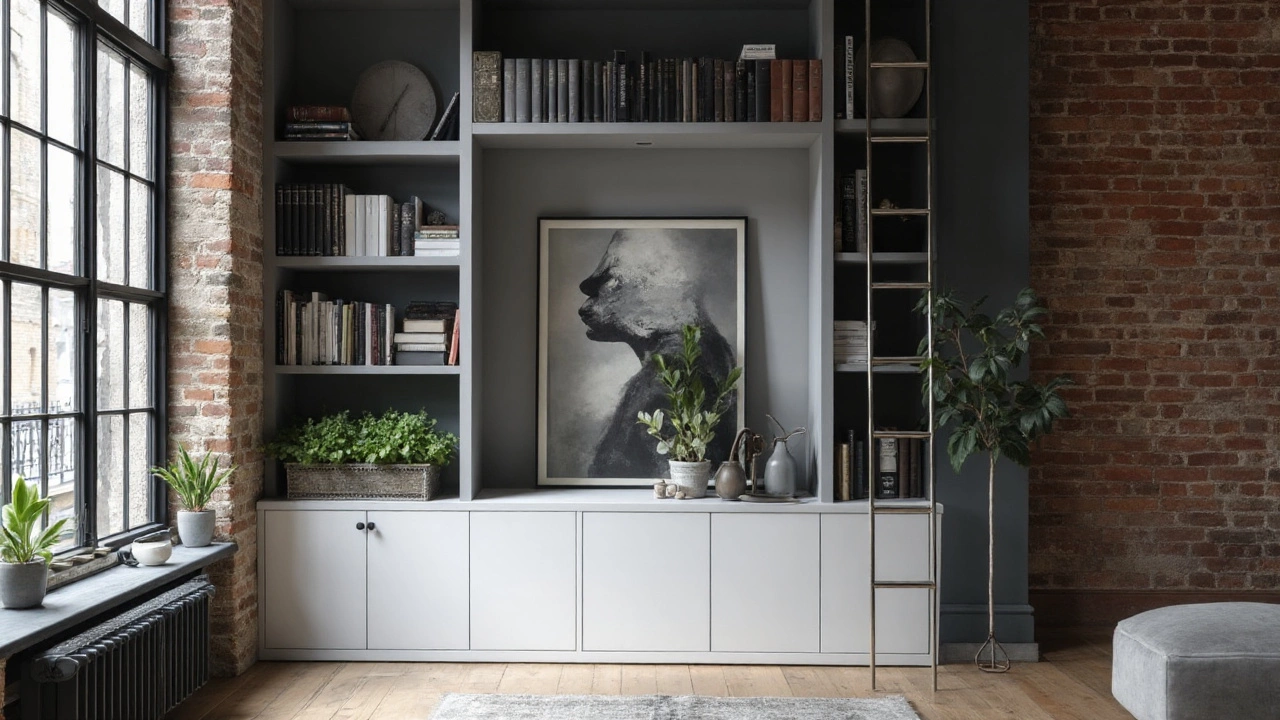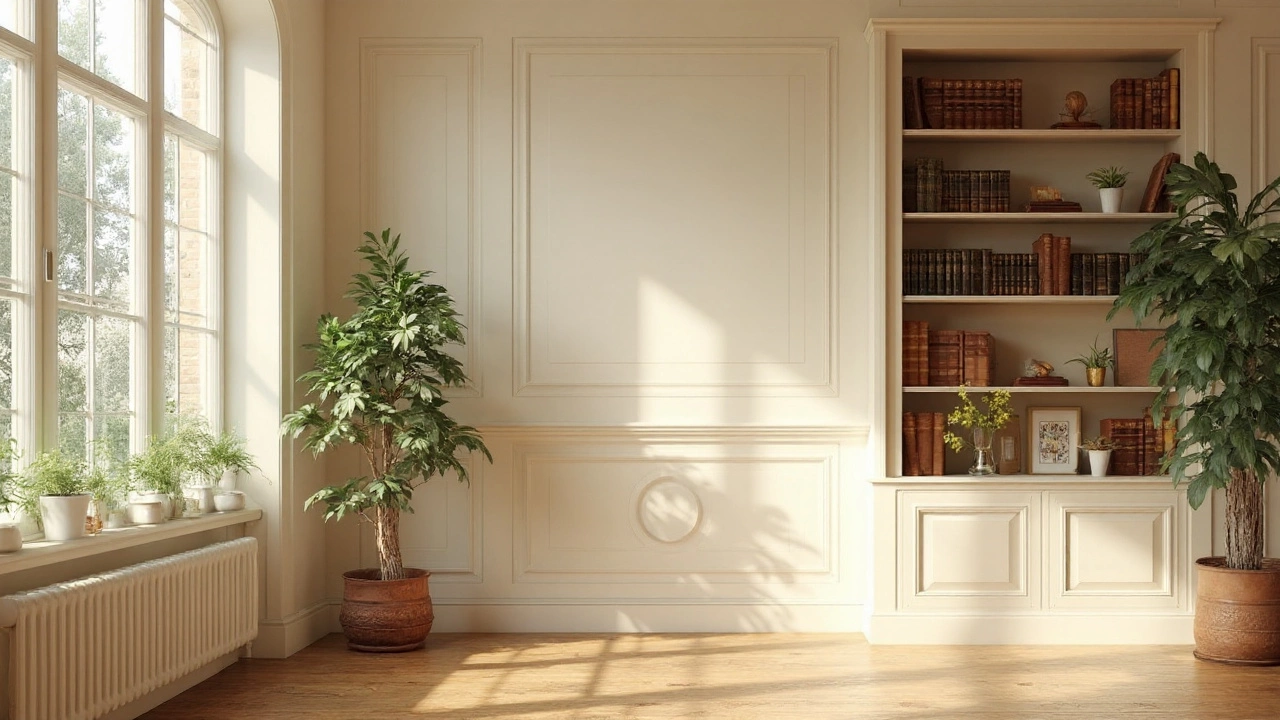Bookcase Color Decision Helper
Built‑in Bookcase is a custom or semi‑custom shelving unit that is integrated into a wall structure, providing storage while acting as a design element. Homeowners often ask whether the built‑in bookcase color should echo the surrounding wall paint. The answer isn’t one‑size‑fits‑all; it hinges on room size, lighting, interior style, and the visual hierarchy you want to create. This guide walks you through the decision‑making process, supplies a handy comparison table, and offers concrete examples so you can confidently choose a finish that compliments your space.
Why Color Matters in Built‑in Bookcases
Color influences perceived dimensions, mood, and the flow of visual attention. When a bookcase blends with the wall, it can disappear into the background, emphasizing the items it holds. Conversely, a contrasting hue makes the shelving a focal point, adding depth and character. Understanding the role each color plays helps you align the bookcase with your design goals.
Key Entities That Shape Your Decision
Below are the primary design elements that interact with a built‑in bookcase. Each entity is introduced with its most relevant attributes.
- Wall Paint is a coating applied to interior walls, defined by hue, finish (matte, satin, gloss), and light reflectance. Typical hues range from soft neutrals (e.g., 40% off‑white) to bold pigments (e.g., 120° teal).
- Trim Molding is a thin wood or MDF profile that frames doors, windows and built‑ins, often painted or stained. Common finishes include white lacquer (R=255, G=255, B=255) or natural oak (L*≈70).
- Accent Color is a secondary hue used in décor items like cushions, artwork, or a single wall to create visual interest. Popular accents in 2025 are mustard (H=45°, S=80%, L=55%) and muted navy (H=210°, S=60%, L=30%).
- Interior Style is a design language that guides material, colour, and furniture choices; examples include Minimalist, Traditional, Industrial, and Eclectic.
- Lighting is a combination of natural daylight and artificial fixtures that affect colour perception, measured in lumens and colour temperature (K). Warm LEDs (≈2700K) soften contrast, while cool LEDs (≈4000K) highlight differences.
- Flooring is a surface covering such as hardwood, laminate, or carpet, contributing to the room’s colour palette and reflectivity. Light oak flooring (L*≈80) can make a dark bookcase feel grounded.
- Ceiling Color is a paint hue applied to the upper plane of a room; lighter ceilings (e.g., 95% white) amplify vertical space.
Decision‑Making Framework
Use the following three‑step framework to decide whether your built‑in bookcase should match the wall:
- Assess Room Scale. Small rooms benefit from monochromatic schemes because they reduce visual clutter. Large rooms can handle contrast without feeling cramped.
- Identify Desired Emphasis. If the books, objects, or art on the shelves are the highlight, a contrasting colour makes them pop. If you prefer the collection to fade into the background, match the wall.
- Cross‑Check With Existing Palette. Look at the trim, flooring, and ceiling. Matching the bookcase to the wall works when other elements already provide contrast (e.g., dark flooring with light walls).
Comparison of Colour Strategies
| Strategy | Visual Impact | Best For Room Size | Style Compatibility | Maintenance |
|---|---|---|---|---|
| Same as Wall | Seamless, spacious feel | Small to medium | Minimalist, Scandinavian, Modern | Easy - same paint schedule |
| Contrasting Colour | Bold focal point | Medium to large | Industrial, Eclectic, Traditional | Requires occasional touch‑ups on high‑traffic shelves |
| Two‑Tone (Wall + Shelf) | Balanced depth | All sizes (depends on contrast level) | Transitional, Contemporary | Moderate - two paint finishes to monitor |

Real‑World Scenarios
Scenario 1 - A 10‑ft living room with light gray walls. The homeowner loves a Minimalist vibe and has white trim. Painting the built‑in bookcase in the same light gray makes the room appear larger, while arranging a few colourful vases adds a subtle pop without breaking the continuity.
Scenario 2 - A 15‑ft study with deep navy walls. The space features walnut flooring and brass lighting. A contrasting chalk‑white bookcase creates a striking backdrop for dark leather books, reinforcing a Traditional‑Industrial blend.
Scenario 3 - A 12‑ft bedroom with pastel teal walls. The room includes cream trim and a patterned rug. Opting for a two‑tone scheme - pastel teal wall, slightly lighter teal bookcase - offers depth while keeping the colour palette soft and cohesive.
Practical Tips for Painting Built‑in Bookcases
- Prep the Surface. Fill any gaps with wood filler, sand to a smooth 220‑grain finish, and clean with a tack cloth.
- Prime First. Use a high‑quality primer (e.g., oil‑base for dense wood) to ensure colour fidelity. Allow 2-3 hours drying.
- Choose Paint Finish Wisely. Matte or low‑sheen finishes hide fingerprints on shelves; semi‑gloss adds durability for high‑use areas.
- Test Colour Samples. Paint a 6‑inch patch on the side panel, view it under day‑light and evening lighting before committing.
- Coordinate With Trim. If you plan to highlight trim, consider a subtle shade difference (e.g., wall 50% lighter than trim) to avoid a harsh line.
Related Concepts to Explore
Understanding the colour dynamics of a built‑in bookcase opens doors to broader design topics:
- Colour Theory. Learn how complementary and analogous palettes can guide your choice.
- Visual Balance. Study how mass and negative space affect perceived equilibrium.
- Texture Integration. Mix painted surfaces with natural wood or metal to add tactile interest.
- Lighting Design. Adjust floor‑lamps or wall‑sconces to enhance the chosen colour scheme.
Next Steps for Readers
After reading this guide, you’re ready to take action:
- Measure your room and note existing colour values (wall, trim, floor).
- Choose a strategy from the comparison table that aligns with your space and style.
- Gather paint samples, prime, and tools - a small investment saves future rework.
- Apply the practical tips to achieve a flawless finish.
- Re‑evaluate the room after installation; adjust lighting or accessories if needed.
Frequently Asked Questions
Will a matching bookcase make a small room feel bigger?
Yes. When the bookcase shares the wall colour, it creates a continuous plane that reduces visual breaks, making the space feel more expansive. Pair it with good lighting and minimal décor for the best effect.
Is it okay to paint a bookcase a darker shade than the walls?
Absolutely, provided the room is well‑lit and the contrast isn’t overwhelming. Dark shelves can anchor a room and showcase lighter objects, but avoid using the same dark hue on walls and floor to prevent a cave‑like feel.
Should I use the same paint finish on the bookcase as the walls?
Not necessarily. Walls often use matte or low‑sheen finishes to hide imperfections, while shelves benefit from a slightly glossier coat that resists stains and makes cleaning easier. A satin finish is a versatile middle ground.
How do I choose an accent colour that works with a matching bookcase?
Pick an accent that sits opposite the bookcase on the colour wheel (e.g., teal walls with burnt orange accents) or use a neutral tone (like warm beige) for a subtle lift. Introduce the accent through cushions, artwork, or decorative vases.
Can I paint a built‑in bookcase without removing it?
Yes, but you’ll need to protect surrounding walls and flooring with drop cloths and painter’s tape. Use a low‑odor primer and paint to keep fumes low, especially in confined spaces.


Write a comment